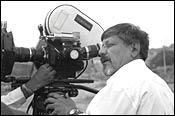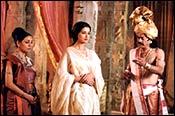 | « Back to article | Print this article |
 Nobody believed me when I said I was going to a reading of the script of Amol Palekar's newest venture Anaahat to see how well Sonali Bendre speaks Marathi.
Nobody believed me when I said I was going to a reading of the script of Amol Palekar's newest venture Anaahat to see how well Sonali Bendre speaks Marathi.
The wife could not stop smirking as I shaved that morning. I shave once in two weeks or so, which is frequent enough for a journalist. And it was just one of those days when I felt like it. But she could not stop smirking.
At the office, friends noticed I was wearing leather shoes, not my dirty, worn floaters.
It had stopped pouring in Mumbai just last week and I thought it was time to bring my formals out. It had absolutely nothing to do with Ms Bendre. Nobody believed me.
But all the attention got me thinking: wouldn't Anaahat get a little overshadowed by Sonali Bendre's star status? Wouldn't Palekar be asked the question, why Sonali Bendre?
Everybody knows the kind of cinema she has been associated with so far and everybody knows the kind of cinema Palekar, as a director-producer, is identified with. Where is the common ground?
![]()
More on rediff.com!
![]()
![]()
![]()
![]()
Golmaal: Of men and moustaches![]()
Marathi film industry in deep trouble![]()
![]()
![]()
Or is it kind of a crossover film for both -- for Palekar to move a little towards 'popular cinema' and for Bendre to move away from it?
Palekar in an interview published on rediff.com soon after he had made Kairee, the story of an adolescent girl supplanted in an adult world, had called 'popular cinema' a misnomer.
It is difficult to argue with that. More than 95 per cent of 'popular cinema' goes pop at the box office. Can cinema that is not popular be called 'popular cinema'?
But Palekar's shift towards popular cinema with Anaahat may not extend to content or style, or even the subjects he is wont to pick up. It may just mean getting his movies to more cinema halls in the country. His previous movies, to a very large extent, were 'festival circuit' movies because exhibitors would not touch them.
Kairee, Dhyaas Parva, Akriet were not mainstream fare, a term Palekar hates, because they did not reach the common people. These movies did not play in Kolhapur in Maharashtra, Ludhiana in Punjab, or Hamirpur in Himachal Pradesh.
But Anaahat may just do. And that is where Sonali Bendre comes in.
 It is still an Amol Palekar film. Even if it is a crossover film, it will be so on his terms. Anaahat being made in Marathi proves that Palekar will only do what he believes in. That is, 'Palekar cinema'.
It is still an Amol Palekar film. Even if it is a crossover film, it will be so on his terms. Anaahat being made in Marathi proves that Palekar will only do what he believes in. That is, 'Palekar cinema'.
A warm welcome, Madam Bendre.
The script reading was at the Cha (tea) Bar at the Oxford Book Store near Churchgate station, south Mumbai. There was a sizeable crowd of journalists and the Marathi press was present in strength.
Amol Palekar, dressed in black trousers, suspenders, and a Chinese-collar white cotton shirt, looked relaxed. Sonali Bendre (I promise to finish this quickly) -- is she good-looking or is she good-looking! An off-white raw silk churidar complemented her glowing complexion, streaked golden tresses, that million-watt smile and, ok, ok, I am getting back to the subject.
After indulging the 'mainstream' media (read television journalists) with half-a-dozen interviews and keeping the 'parallel media' (read print, web) waiting for a good hour, Palekar, Bendre and Pradeep Welankar stepped on to the stage.
The director-producer read out the synopsis of the movie after a brief preview. Since the preview was apparently only for the 'mainstream media', they used all the bodies and equipment at their disposal to block it off from a large part of the audience.
| |||||||||||
The king, played by Anant Nag, is impotent and hence unable to provide a heir to the throne. This, however, does not come between him and his queen, played by Bendre, from sharing a good relationship.
But their world comes crashing down when the state's governing council suggests niyog -- a practice described as selection of a mate for a woman incapable of conceiving from her husband -- for the queen.
The queen's permission is not sought, but she gets to choose her mate.
The film, an adaptation of Surendra Verma's Hindi play Surya Ki Antim Kiran Se Surya Ki Pehli Kiran Tak is a journey through one night -- the night of niyog -- and the upheaval it brings in two lives intertwined by a common fate.
The film was shot in 18 days in Hampi, a world heritage site near Hosbet, Karnataka. Palekar required special permission from the Archaeological Survey of India to shoot deep within the ruins of the Vijaynagar empire and also after sunset.
Palekar said a lot of research went into designing the sets (Nitin Desai is the art designer) and the costumes for the film. And to make sure the effects were real, he used authentic gold jewellery.
Between the three of them -- Palekar, Bendre and Welankar -- they read out two scenes that, by any reckoning, sounded like the centrepieces of the movie.
![]()
Image galleries
![]()
![]()
![]()
![]()
Madhuri's sexy moves!![]()
Be as sexy as Urmila!![]()
![]()
![]()
The first was a conversation between the queen and the chief minister, played by Welankar, on the eve of the niyog night, where the queen raises some tough questions.
The dialogues were pithy, yet full of drama. Bendre speaks Marathi rather well I must say, but please don't get me started again.
The second scene that was read out related to the niyog night, with the king awaiting the queen's return. It had two characters: the king and his childhood friend Mahattarrika, played by Deepti Naval. This scene was read out by Amol Palekar. It was the piece de resistance.
The king is distraught. Having been forced to decree his queen into niyog, he is angry. Angry with his ministers, angry with the queen, angry with himself.
As he mumbles to himself ignoring Mahattarrika's entreaties to take some rest, he sees a conspiracy by the state's governing council one moment to degrade him in the eyes of his subjects; the next he wants to know why it is taking the queen so long to return.
 He poignantly recalls a question the queen had asked him just hours before leaving the royal chambers to be with her chosen mate. How would he see the child conceived from this one-night stand? As his heir apparent or his son?
He poignantly recalls a question the queen had asked him just hours before leaving the royal chambers to be with her chosen mate. How would he see the child conceived from this one-night stand? As his heir apparent or his son?
The king had no answer.
The film will be released with subtitles for audiences that do not follow Marathi.
Palekar said he did think of making the movie in Hindi, but the more he discussed the subject with his team, the more he was convinced that it sounded better in Marathi.
"Everybody is asking me why I have made this movie in Marathi," he said. "Was this question ever posed to Satyajit Ray? Does anybody ask Mrinal Sen why he makes movies in Bengali? And I tell you, more Maharashtrians ask me this, because we have very little confidence in our language. We feel diffident about it.
"But I will never let such diffidence come in the way of my work."
Bendre on her part was happy that for the first time in her career she was told it was okay to underact.
Somebody must tell Bollywood that melodrama -- a hangover from the stage -- should have been deposited in creativity's waste bin as far as films are concerned a long time ago.
Click here for More Features